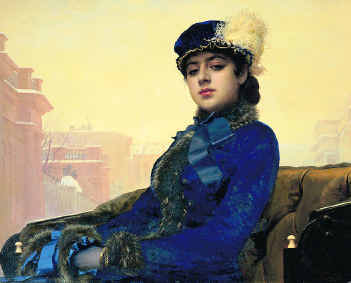The Tretyakov Gallery's collection covers a period of nine centuries.
Topic: Art Galleries
| The Tretyakov Gallery's collection covers a period of nine centuries. |
Apart FROM buying readily available portraits, Tretyakov also commissioned new works by contemporary artists, thus transforming the collection into a veritable centre of Russia's artistic life.

THE second half of the 19th century saw a powerful movement in Russia initiated by a unique assembly of artists historically called the Wanderers. Rejecting the strict canons of the academic system, the Wanderers chose to bring their art to a wider and larger public by organising itinerant exhibitions. The underlying theme of these exhibitions was art as a tool for social commentary and criticism, especially of the inhuman living conditions and political and social repressions of their time.
Art to the masses
In 1870, several artists formed the Society for Travelling Exhibitions trying to "bring art to the masses" and to portray the everyday life of the common people. Called "Ideological" or "Critical" Realism, the works of these artists ran parallel to the principles and ideals of the great Realist Russian writers like Dosteyevsky, Turgenev and Tolstoy.
The vivid narrative content of the works of Vasily Perov (1834-83) and Vasily Pikuriev (1832-90) brought to the public eye the hard and exploited life of the downtrodden. Perov's "Troika" and "Village Walk of the Cross of The Easter" and Pikuriev's "Misalliaance" are striking examples of Critical Realism. Nothing speaks more poignantly than the forlorn look of the dowry less young woman at her wedding to an ancient groom in "Misalliance". So is the fate of the young bride in whose ears a crone is whispering in "Fortune-teller at the village wedding" by Vasily Maksimov (1844-1911).
Support for the movement
It is indeed remarkable that a rich Moscow merchant and a textile mill owner, Pavel Mikhailovicyh Tretyakov (1832-1898), not only shared the social concerns of the Wanderers, but also encouraged and supported the movement. His unmatched collection of the itinerant exhibitions formed a big section of the Tretyakov Gallery. In Tretyakov's eyes the Wanderers were the first independent artistic society.
Tretyakov, a strong and prominent figure in Russian cultural life, acquired paintings that were strongly criticised or banned by censors. But, because of his unassailable position, Tretyakov's patronage became a sign of public acknowledgement and acceptance. Apart buying readily available portraits, Tretyakov also commissioned new works by contemporary artists, thus transforming the collection into a veritable centre of Russia's artistic life.
Vasily Perov's portrait of writer Dostoyevsky, commissioned by Tretyakov in 1872, seems to convey the psychology of the writer. Ivan Kramskoy's portrait of Tolstoy falls in this category of holding high the idols of their times to the full view of posterity.
Another great portrait by Kramskoy is that of the "Unknown Woman" (oil on canvas, 1883) a mysterious aristocratic lady, which always competes for public attention with Karl Bryullov's "The Rider", which revolutionised the genre of portrait painting by catching the subject in action.
Orest Kiprensky's works are a class apart. His masterpiece is the 1827 portrait of Alexander Pushkin. It is not just a picture; it is a study in character. The darker colouring makes Pushkin more sombre, more thoughtful and fiercer, almost predicting the impending fatal duel as inevitable.
Ivan Shishkin (1832-98), Russia's finest landscape painter, combined in his colouring and brushwork photographic details with an element of lyricism. "Rain in the Oak Forest", "Noon in the Moscow Countryside" and "The Corn" are for the Russians the most beloved and nostalgic descriptions of their motherland.
Tretyakov started his collections in 1856. In four years' time he realised the purpose and mission of his work. "For me, a true and ardent lover of painting, there can be no finer wish than to found a universally accessible repository of fine arts, which will benefit and give pleasure to all," wrote Tretyakov in 1860, adding "I... should like to leave a national gallery, that is, a gallery with pictures by Russian artists." In 1892 Tretyakov presented Russia with a large and already famous gallery containing about 2,000 paintings, drawing and sculptures. And anyone, irrespective of his rank and social status, could visit the gallery on any day of the week.
Nationalised
After the 1917 revolution, Tretyakov Gallery was nationalised and became The State Tretyakov Gallery — The National Museum of Russian Fine Art. Works by European painters and artists were removed and Russian works from other private collections that were confiscated by the State were added to Tretyakov's catalogue. The State Tretyakov Gallery richly and justly deserves being referred to as one of the greatest museums of the world.
Harmonious juxtaposition
What is remarkable is the harmonious juxtaposition of various schools, different styles and different mediums spread alongside of each other to project a continuous picture of Russian art done solely by Russian artists. The icons of the 13th-15th centuries merge without any contradiction with the Soviet realism of the 20th century as seen in Deinika's "Future Pilots" (1938) and "At the construction of the new factory shops" for the latter's works capture the spirit of the times as much as Rublev's icons generate warmth in the hearts of the Russians.
2006 marked the 150th anniversary of the Tretyakov gallery. It was a great occasion for celebrations, not only by Russians but also by artists and museums from all over the world. The year long festivities lent a universal character to what is basically a true Russian collection, made possible, as President Putin said, by the "selfless devotion, enthusiasm and generosity of spirit of this wonderful man, patron of the arts and educator Pavel Mikhailovich Tretyakov."
Posted by pmoh-iras-russian-cis bureau
at 12:52 AM EST

